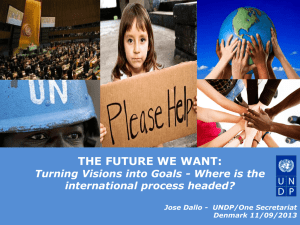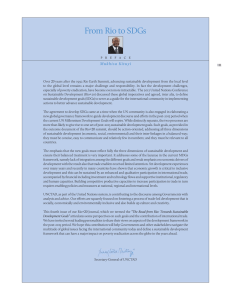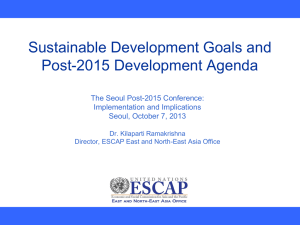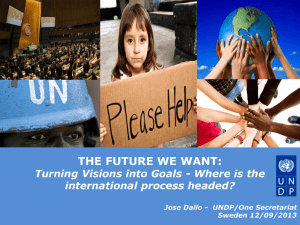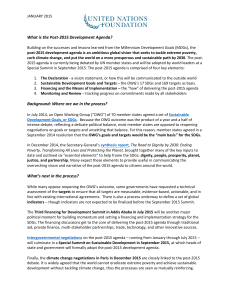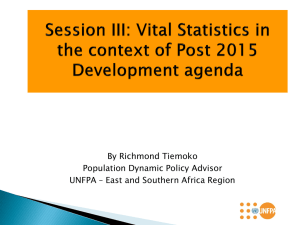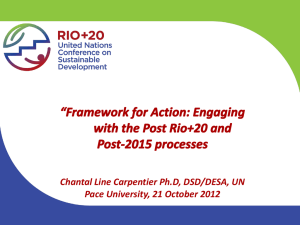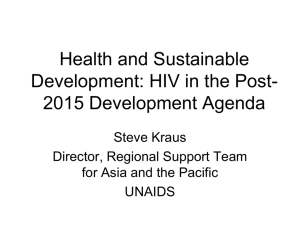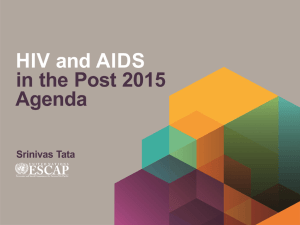Read Olav`s full piece here
advertisement
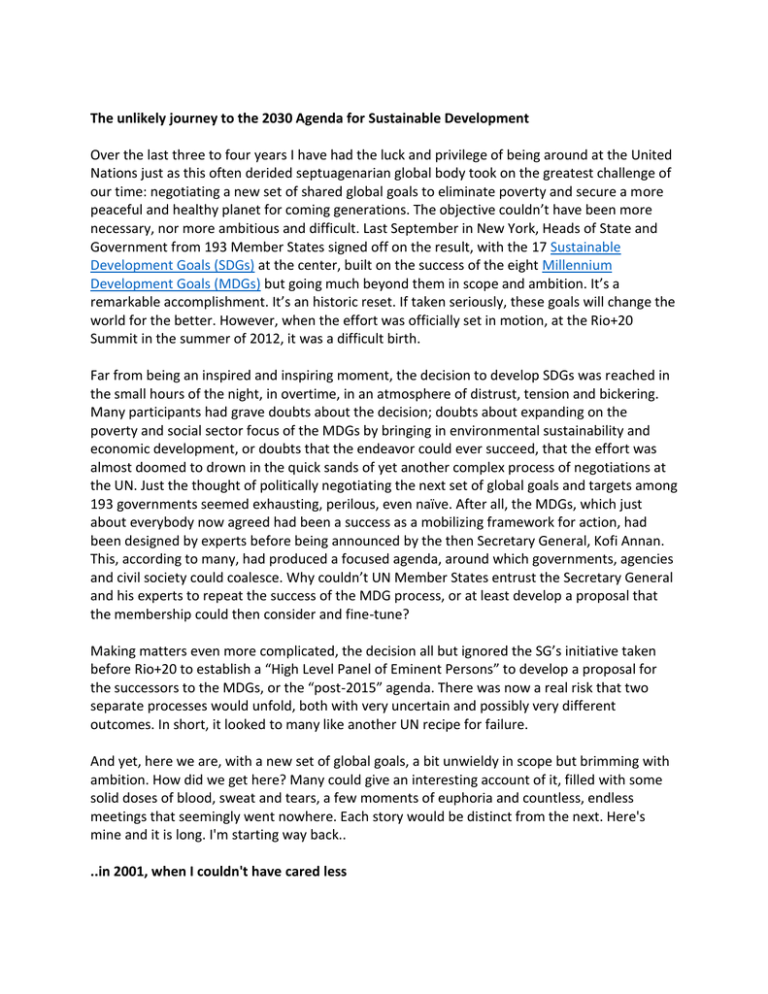
The unlikely journey to the 2030 Agenda for Sustainable Development Over the last three to four years I have had the luck and privilege of being around at the United Nations just as this often derided septuagenarian global body took on the greatest challenge of our time: negotiating a new set of shared global goals to eliminate poverty and secure a more peaceful and healthy planet for coming generations. The objective couldn’t have been more necessary, nor more ambitious and difficult. Last September in New York, Heads of State and Government from 193 Member States signed off on the result, with the 17 Sustainable Development Goals (SDGs) at the center, built on the success of the eight Millennium Development Goals (MDGs) but going much beyond them in scope and ambition. It’s a remarkable accomplishment. It’s an historic reset. If taken seriously, these goals will change the world for the better. However, when the effort was officially set in motion, at the Rio+20 Summit in the summer of 2012, it was a difficult birth. Far from being an inspired and inspiring moment, the decision to develop SDGs was reached in the small hours of the night, in overtime, in an atmosphere of distrust, tension and bickering. Many participants had grave doubts about the decision; doubts about expanding on the poverty and social sector focus of the MDGs by bringing in environmental sustainability and economic development, or doubts that the endeavor could ever succeed, that the effort was almost doomed to drown in the quick sands of yet another complex process of negotiations at the UN. Just the thought of politically negotiating the next set of global goals and targets among 193 governments seemed exhausting, perilous, even naïve. After all, the MDGs, which just about everybody now agreed had been a success as a mobilizing framework for action, had been designed by experts before being announced by the then Secretary General, Kofi Annan. This, according to many, had produced a focused agenda, around which governments, agencies and civil society could coalesce. Why couldn’t UN Member States entrust the Secretary General and his experts to repeat the success of the MDG process, or at least develop a proposal that the membership could then consider and fine-tune? Making matters even more complicated, the decision all but ignored the SG’s initiative taken before Rio+20 to establish a “High Level Panel of Eminent Persons” to develop a proposal for the successors to the MDGs, or the “post-2015” agenda. There was now a real risk that two separate processes would unfold, both with very uncertain and possibly very different outcomes. In short, it looked to many like another UN recipe for failure. And yet, here we are, with a new set of global goals, a bit unwieldy in scope but brimming with ambition. How did we get here? Many could give an interesting account of it, filled with some solid doses of blood, sweat and tears, a few moments of euphoria and countless, endless meetings that seemingly went nowhere. Each story would be distinct from the next. Here's mine and it is long. I'm starting way back.. ..in 2001, when I couldn't have cared less I served as State Secretary of International Development in Norway when Secretary General Kofi Annan announced the MDGs. Honestly, I didn't have much time for them. They seemed to me an overly simplistic approach to something as complex as development, at the expense of serious policy making and complex reforms. I viewed them as a smart move communications wise, but that was it for me. But by 2005, things had changed By then I could see the difference that a set of shared goals was now making. I joined UNDP that same year, an organization that played a central role in grounding the MDGs in countries around the globe. The goals were forcing stronger political attention to critical poverty and health deprivations causing misery for billions of people. They had helped reverse the decline in ODA that we saw in the 1990s. They were starting to seep into national development strategies and budgets, and international partners were using them to guide priority setting. Global partnerships were being formed or revitalized to support stronger action. As a “common currency” they were making aid coordination a bit easier. I could see that there wasn't an either/or between a set of shared, morally compelling goals and more “brainy” development policy. At the same time, I and others worried about the MDGs’ lack of attention to governance, conflict and violence, and the cursory treatment of job creation and environmental challenges. By 2008, I was on the barricades The global financial crisis in 2008-9 nearly killed off global commitment to the MDGs. I witnessed several conversations with policy makers where it was suggested that it was time to move on, to redefine the agenda. People were tired of yesterday’s concepts. With the arrival and leadership of Helen Clark as UNDP Administrator, we and other partners launched a big counter offensive, mobilizing developing countries to tell their stories about the difference the goals were making. It worked. The MDG Summit in 2010 took stock of the encouraging progress being made around the world, renewed commitments despite the overall gloomy economic picture, and ushered in a major acceleration program led by UNDP to zoom in on gaps and bottlenecks country by country. At this summit, conversations were heard for the first time about “post-2015”. What do we do after the MDG deadline? The SG wisely announced that focus had to remain on finishing the MDG job, but that he would initiate an “inclusive and transparent” dialogue on what should happen next. That got me and others thinking. "We the People of the United Nations" It seemed obvious to me and many colleagues that “pulling a quick one” like Kofi Annan did in 2000-1 by simply announcing goals and targets formulated by experts, would be both totally wrong and politically impossible this time around. There would have to be some kind of open and inclusive process, in order to build support and legitimacy. Everybody now knew how powerful the MDGs had become. There was no way different countries and other constituencies would simply sit back and await the wisdom of experts at the UN or anywhere else. At a minimum, governments around the world would take a huge interest in debating what the focus of the next goals should be. We also saw a huge opportunity: unlike at the beginning of the millennium, it was now possible – due to advances in computer-mediated and mobile communications and the growth in bottom-up civil society policy networks – to create a virtual global conversation, to bring millions into a UN-led effort to define “the world we want”. I felt this was an opportunity that the UN could not afford to miss, a way to breathe life into the opening words of the UN Charter: “We, the people of the United Nations”. As “co-chair” of the “MDG Task Force” which brought together representatives from all UN development agencies, I introduced a proposal, developed by UNDP colleagues Paul Ladd and Jose Dallo, for that global conversation. It laid out a plan for unprecedented national consultations in scores of countries around the world, multiple thematic consultations with experts and practitioners at the global level, and an on-line engagement platform audaciously named worldwewant2015. Later, Paul Ladd (UNDP) and Claire Melamed (ODI) proposed a massive on and off-line survey to capture the priorities of people everywhere, MyWorld2015. Over the course of late 2011 and early 2012 we built support for the whole package, revised it several times, and got it approved and then funded by several partners. By mid-2012 we were ready to roll, but awaiting what would come out of the Rio+20 Conference. I also found myself co-chairing a UN system-wide “Post-2015 Task Team” that the Secretary General set up to prepare an initial, “stage setting” report aimed at providing strategic recommendations on the issues that a new agenda and new goals would need to grapple with. Some 60 UN agencies and offices around the world signed up to take part in it. Many were the times I was told what a hopeless task we had, that this project was doomed to fail. Apparently there was no way that 60 specialized entities could ever agree on a shared vision. We brushed that aside while making it clear to colleagues in the Task Team that we all had to rise to the occasion, above narrow agency mandates, to prove the skeptics wrong. This was our chance within the UN to shape the direction of the agenda. If we ended up with what many expected -a "Christmas tree" sprinkled with each entity's favorite decorations -- all of us and the UN as a whole would look incapable and silly. Meanwhile, at UNDP we cleared an entire floor to host a UN-wide secretariat tasked to promote a coherent effort across the system. Paula from Colombia stops by to talk One day in mid-2011, a former UNDP colleague and now Foreign Ministry official from Colombia, Paula Caballero, stopped by in my office. The conversation had a profound impact on how I viewed the scope, direction and ambition of the post-2015 agenda. Paula told me that Colombia would go all out for a new framing of the global development agenda. Colombia, she said, wanted renewed, global commitment to sustainable development, given the urgent economic, social and environmental challenges we were now facing. In short, Colombia—and Paula especially—wanted Sustainable Development Goals. And they wanted them agreed at the Rio+20 Summit the following year, or at least get an agreement to develop such goals. These SDGs, she said, should apply universally, to all countries, North and South. I asked her if she thought she could get sufficient political support from other countries. She looked at me and said: “Yes, but we need your help. Can you, and can UNDP, help us?” Conflicting thoughts ran through my head. On the one hand, I was deeply moved and excited. Paula had laid out a vision that coincided with my own thoughts. I totally agreed that we needed a new framing, and that sustainable development and universality had to be key ingredients. But I was worried too. There would be staunch opposition. A lot of people saw no need to go much beyond an upgrading of the MDGs, with continued focus mainly on addressing poverty in poor countries. Even though sustainable development had been embraced by the world almost 20 years earlier as a balancing act across economic, social and environmental priorities, a lot of people saw sustainable development as nothing more or less than a euphemism for environmentalism and wanted to leave the entire concept behind. Very few were excited about the Rio+20 conference. Many were surprised that Brazil even wanted to bother with another Rio summit. Bringing the discussion to Rio could also derail and politicize the post-2015 process as we had been contemplating it within the UN system. And, what sort of clout could Colombia have anyway? But, I knew that Paula had the right vision and I threw doubts and caution to the side. “Yes,” I said, “I'm with you.” I also told her that getting the actual goals agreed in Rio would not be wise nor possible. Much more time would be needed in order to allow for an inclusive and open process, and for the political proceedings that would be needed. Besides, we had until the end of 2015 to work it all out. June 2012: A near-death experience in Rio By Rio+20 in June, Colombia had done an incredible job mobilizing support for SDGs. A “hard core” of several Latin American and European countries were working near-seamlessly to build support for the idea. The host nation Brazil was engaged with strong ideas of their own while ceaselessly reading the political landscape looking for ways to find common ground. This was critically important, as there was plenty of opposition at several levels. Some didn't like the idea of SDGs at all, while others fought against having a decision that would unleash a political negotiation process to determine the goals. It was becoming increasingly clear that developing countries were quite united behind a demand for negotiations. Their “nothing about us without us” argument was hard to argue against. In the months prior to Rio I had been busy on two fronts: First, together with colleagues I had been using the run-up to build support in UNDP and the wider UN system for a broader framing of the agenda than we had contemplated so far. The UN Task Team’s report became a particularly important tool for widening understanding and support for embracing sustainable development and universality, and we went beyond that to making the case for tackling inequality, conflict and violence, and governance. It was issued after Rio, but it's thinking (and advanced drafts) was already in circulation. Secondly, we invested in dialogue with a wide range of governments and civil society actors to build greater appreciation for the imperative of a more integrated, less siloed approach to development and how sustainable development as a concept and SDGs as shared commitments could be instrumental. In a nutshell, we felt that the real challenge before us was to once and for all bring together two rather entrenched communities, with largely separate worldviews and even separate governing bodies: One dedicated to (economic and social) development and the other to (mainly environmentally) sustainable development. However, many saw it differently. A number of governments did not see “post-MDGs” and SDGs as necessarily one and the same. Some felt that a successor framework to the MDGs would be needed to maintain commitments to development cooperation and to finishing the job of eradicating poverty, while the SDGs would address other, more global challenges. The host country Brazil was the lead proponent of this view, while at the same time skillfully searching for a consensus formula. With the risk of two separate post-2015 tracks growing almost by the day, we were working extra hard to argue for one consolidated effort, while preparing for the possibility of having to support two separate tracks. A forum of Member States in New York regularly convened by Japan became particularly important during this period, preparing the grounds for what was to come. Only weeks before the opening of Rio, Prime Minister David Cameron announced that he would be leading a High Level Panel on the Post-2015 Agenda, to be established by the Secretary General. The news deepened tensions and distrust in the already difficult negotiations ahead of Rio, which were then in the final rounds. Many developing countries saw the panel as an attempt to “override” what they saw as an imperative to be confirmed in Rio: an intergovernmental process, led by Member States themselves. On the other hand, many developed countries felt that a proposal had to be developed first, before entering negotiations. Otherwise, it would be extremely difficult to produce a meaningful result. They saw the panel as a way to achieve this. During tense days and nights in Rio I found myself in the corridors and negotiation rooms, trying to be helpful. I realized that any agreement reached would have to include a decision to undertake an intergovernmental process to define the goals, otherwise the SDGs as a viable concept would die right in Rio. On the other hand, developed countries could not support such an approach without language that would somehow connect the SDGs to the post-2015 development agenda, and they were also adamant that in addition to the economic, social and environmental dimensions, issues related to peace, democracy and governance also had to be part of the deal. Many pointed out that the new agenda was not only about the legacy of the Sustainable Development Summits; the iconic Millennium Declaration from 2000 also had to be honored, which among other things emphasized the importance of democratic governance. From our side in the UN system, we were working for language that would authorize us to support the negotiations and to bring in the voices of people around the world. For me and my UNDP colleagues, the work of the UN Task Team and the consultations that we were ready to unleash, were hanging in the balance. It all came down to the wire. On overtime and in the wee hours of the night, there was finally a deal, along lines put forward by Brazil as a take it or leave it offer. It implied a distinct process to elaborate SDGs, but it was articulated in such a way that it pointed towards “post-2015” as destination, and it did call for an open and inclusive process and for the UN to provide substantive support. On the other hand, the High Level Panel wasn’t mentioned. Instead, the outcome document mandated the establishment of an “Open Working Group” to be made up of experts from 30 Member States selected from within the UN regional groupings. This group, the OWG, was tasked to develop a proposal to the UN General Assembly, guided by the Rio Outcome Document itself. The mood wasn’t good. Nobody was particularly happy with the outcome, some were incensed, some thought and said “this can never work”. I thought to myself: It has to work. Our job is to make it work. The morning after, I ran into Amina Mohammed, the recently appointed “Special Advisor to the Secretary General on Post-2015 Planning”. We had reached the same conclusion: if we organize ourselves well, we can help make it come together. We returned to New York and went to work. The world we want: the global conversation takes off As summer turned to fall, our ambitious consultation project gathered steam. We were in a great hurry. We knew we had to be able to not only run national and thematic consultations around the globe and get the global MyWorld survey underway, we had to manage to make sense of the results and present consolidated reports in time for the results to be available for the High Level Panel and the OWG. The panel represented the greatest challenge timing wise. It went to work in July with a condensed meeting schedule and aiming to have a report ready by June 2013. We knew we had to be able to present at least early results by late winter of 2013, and a final report ahead of the General Assembly in September. But UN country teams responded to the challenge with speed and agility. They were staging and facilitating national consultations around the world, bringing a vast array of people and constituencies into the expanding post-2015 loop: women’s organizations, youth groups, farmers, big and small business, labor organizations, slum dwellers, people with disabilities, indigenous people, ethnic and sexual minorities, and more. In parallel, UN agencies took the lead in organizing the global thematic consultations, bringing experts and interest groups together into large virtual loops combined with meetings hosted by countries with a particular interest in a given theme. The consultations covered the MDG areas, but also stretched out into the controversial areas that would become the SDGs: governance, security and disasters, inequalities, population dynamics (migration, age), and of course environmental sustainability. In a way they circumscribed the topics and gave the initial trajectory to the SDGs. The UN Millennium Campaign under the leadership of Corinne Woods, had designed MyWorld2015 as a UN-Civil Society-Private Sector partnership, and it was quickly gathering votes from around the world. In parallel the UN Global Compact was mobilizing interest in the private sector, producing a report capturing business perspectives and recommendations. Jeffrey Sachs, Director of the Earth Institute at Columbia University and the SG’s Special Advisor on the MDGs, launched the Sustainable Development Solutions Network, dedicated to generating contributions and recommendations from the academic and scientific communities. By early 2013, the global conversation was unfolding. The www.worldwewant2015.org web portal captured it all as it happened. The name had been a leap of faith: we had been far from certain that involving millions in the process would produce any clear patterns and priorities. As a matter of fact, many had criticized the effort on the grounds that we would get millions of views but fail to make sense of the result, risking to disappoint both the High Level Panel and the OWG, but more importantly letting down everybody we had brought in on the promise of being heard. However, now we found ourselves marveling at the emerging results: there were clear patterns emerging. It turned out that people around the world had a fairly clear idea about the world they wanted to live in, there were clear recurrent concerns and wishes coalescing into commonly held priorities. We were able to present results to the HLP as it drafted and finalized its impressive report. We were able to share them with governments in capitals around the world, and at the UN just as the OWG finally got underway in March 2013. Perhaps most important, the results revealed that both North and South in important respects had been right in Rio: In essence, the world people wanted was one where we would both build new goals that would meet the bar of sustainable development, but also honor and build on the MDGs and capture key elements from the Millennium Declaration that had been left out of the MDGs, especially freedom from violence and fear, and responsible governance. They certainly in many respects validated the vision that Paula and Colombia had first put forward. Finally, the consultations left no doubt about one thing: People around the globe absolutely wanted shared, global goals. The High Level Panel delivers but who will listen? With consultations still running at full steam, spring 2013 saw the High Level Panel entering its final rounds of deliberations. Together with colleagues I had engaged actively to make sure the Panel had access to the growing body of results from the consultations as it convened its meetings in different parts of the world. Despite considerable differences across the membership, the panel was moving towards a sustainable development framework reflecting two key slogans: “leave nobody behind” and “people and planet”. The still confidential list of 12 proposed goals in many ways echoed and concretized the broad conceptualization of the initial UN Task Team report and reflected many of the patterns we had detected through the consultations. The big question on everybody’s mind, however, was what would happen next? Would the panel report become the proposal that UN Member States would consider through the OWG? Or would it be considered through some kind of separate process? Or would it be largely ignored? During this period I kept hearing UN colleagues ask themselves and others how and when the "separate tracks" would merge. And I kept repeating that the answer was partly in our hands. It was really up to us to work them together by working together. We needed to reinforce the logic of one, shared, global agenda by feeding the same evidence and voices we were now accumulating into all relevant bodies within and beyond the UN. There were now several processes moving at different speeds, and while some trains were coming to their destination such as the panel, others had hardly started the journey. It was only in March 2013 that the OWG finally got underway. Meanwhile, the President of the General Assembly was conducting large thematic sessions of his own on post-2015 with Member States and civil society. UN Regional Commissions organized regional consultations. With all the moving pieces, coordination was a must. Already right after Rio, the Secretary General had constituted an informal coordination team of four senior colleagues with Amina Mohamed in the lead, joined by John Hendra from UN-Women, Shamshad Akhtar from the Department of Economic and Social Affairs (DESA), and myself. We did what we could to encourage collaboration and coherence. In June the High Level Panel presented its final report. It was eloquent, ambitious and quite well received around the world. At the UN some countries were enthusiastic, others politely dismissive. In the OWG the developing countries made it clear that while the report had some good suggestions, it had no formal status and it was up to individual member states to make use of the content in the negotiations, as they saw fit. At the end, this was pretty much what happened. The excellent report with its proposed 12 goals did not become the blueprint many had hoped. But it was far from dead on arrival. Over the ensuing months, it worked its way into the OWG deliberations by osmosis. It helped that quite a number of OWG delegates had also been involved in the panel. A very open working group As predicted by many, the OWG proved to be tough to put together and get going. After months of jostling within the various regional groups, the result was even messier than the Rio outcome: instead of 30 experts from 30 countries, it ended up with 70 countries, organized in 30 small groupings of 2-3 countries, sometimes in unusual constellations (e.g., Japan, Iran and Nepal; India, Pakistan and Sri Lanka). Compounding matters even more, several countries that were not among the 70 made it clear they intended to participate actively. So for all practical purposes, the OWG had become a “committee of the whole” of the UN, and on top of that it had been agreed that “major groups” (civil society, labor, business) would have full access to the proceedings. To many it looked like a train wreck. However, it would soon become apparent that the unconventional but open and inclusive design was actually a key strength. In March 2013 the well-chosen co-chairs of the OWG, Csaba Korösi and Macharia Kamau, Ambassadors of Hungary and Kenya, presented a dense one-year program of work, with monthly 3-5 day thematic discussion sessions in New York through March 2014.. This was to be followed by deliberation of the actual OWG report between March and July 2014, through monthly consultative sessions. During the months prior we had been quietly gearing up to provide support to the demanding agenda, by organizing a dedicated Technical Support Group from across the UN development system with some 40 members. Now, papers were being drafted, reviewed, discussed and revised at feverish speed. In the first substantive OWG session in April dedicated to poverty, I found myself on the podium, presenting key messages from our collective work. I could draw from both the best available knowledge and evidence on the topic from across the UN as well as portray results from the global and national consultations. I felt as I was sitting there that we were helping bringing the famous “separate tracks” together. I also quickly realized that something interesting was going on. This OWG was not your typical UN committee. Despite the inevitable reading of prepared, often stale, statements by some, there were many who reacted to presentations with thoughtful observations and questions in real time. Members were talking among themselves about the issues, as opposed to sticking to traditional positions. It turned out that the unusual combination of countries into small groups was conducive to a more open and informal dynamic as group members had to discuss amongst themselves and coordinate their interventions, making the typical North – South dichotomy of the UN less dominant. The way the two co-chairs led the proceedings, expertly supported by a team from the UN Department of Economic and Social Affairs (DESA) led by Nikhil Seth, was another gift to the process. They set the open and deliberative tone from the get go, and they steadily built trust – often a scarce commodity in multilateral negotiations these days – as month followed month. Third, it helped that all meetings were held in the open, webcast around the world and with civil society organizations as active participants. To me, the most interesting pattern emerging was that there was a group of countries that clearly wanted SDGs more than others. They consistently kept a high degree of pressure on the rest to stay the course and move towards an ambitious outcome worthy of a sustainable development agenda. This informal coalition had started to emerge in the run-up to Rio and included mainly small and mid-size countries, some of them at the high-income level but most were middle income countries. All had democratically elected governments. Colombia was still the central force, but many others had stepped up considerably: Peru, Mexico, Guatemala, Sweden, Norway, the Netherlands, Switzerland, Indonesia, Pakistan, and of course Hungary and Kenya. They all seemed driven by the vision articulated by Paula Caballero: that all countries needed to commit to balancing and integrating economic, social and environmental policy making and action to secure a common future, and that shared goals agreed at the UN and supported by the UN was the only way to achieve this. I wondered optimistically if this was a sign of positive things to come: a new driving force for the common good emerging across the North-South divide, made up of mostly mid-size democracies acutely aware of the need for collective action and multilateralism to address our shared vulnerabilities and solve global challenges. The world, and the UN, would definitely be better off if this were to be the case. A leading U.S. based think tank, World Resources Institute, started to convene periodic retreats to help advance thinking and dialogue among these and an expanding circle of countries as well as some of us from the UN system, with funding from some of the donor countries involved. The retreat explored what an integrated and integrating set of goals and targets could actually look like, the meaning of a universal agenda, and how to go about developing indicators to track progress. Somewhat predictably, among the thorniest issues as the OWG moved into drafting mode in the spring of 2014, were whether or not to have goals related to democracy, governance and peace. Over the course of the OWG’s work, I was intensely involved in informal and formal discussions around these issues, which we in UNDP saw as critical. We saw strong evidence that progress towards the MDGs had been weak or absent precisely in countries hit by turmoil and instability. And the upheavals in many Arab countries had demonstrated that significant MDG progress was far from a sufficient condition for securing sustainable development. Inclusive and fair governance mattered. We saw the new agenda as a unique opportunity to merge two powerful paradigms into one: sustainable development as first articulated by the Brundtland Commission in 1987, and human development as conceptualized by Amartya Sen and Mahbub ul Haq around 1990. At the same time we understood the risk: disagreement ran deep on these issues and could topple the entire project. It went down to the wire in the OWG, but in the end the group managed to reach a difficult compromise on one goal—the iconic Goal 16—dedicated to “just, peaceful and inclusive societies”. Besides Western/Northern countries, many in the coalition mentioned above played an important role, as well as a group of seven post-conflict countries (the socalled g7+) led by Timor Leste, and several African countries. A number of very active CSOs, such as the Open Society Foundation, contributed. It helped considerably that these issues had emerged as a strong priority in the national consultations around the world and the MyWorld survey, which by then had grown to millions of votes. Some key countries reversed or softened their initial resistance in light of these results. In return, the countries most vocal against goals in these areas got a concession: Language specifically on democracy was not included. In addition, the countries of the North had to be more accommodating on core demands from the South: there would be goals on growth and industrialization, and specific targets under each goal for “means of implementation”. The OWG finished its work in July 2014. After the usual frenetic overtime drama that has become a dependable fixture of multilateral negotiations, the co-chairs could announce that the group had delivered on its Rio mandate: to give the General Assembly a proposal for a set of Sustainable Development Goals and associated targets. And what a feat it was: 22 years after the first Rio Conference had established the ideal of sustainable development—of balancing and integrating the economic, social and environmental—the unwieldy OWG had defied the odds and produced a set of truly ambitious and universal goals, with targets that weaved together economic, social and environmental strands across the goals. While many criticized the result complaining that there were way too many goals and targets, or that some targets couldn't be measured or lacked sufficient ambition, I felt immense satisfaction with the result. I was convinced that these goals, if allowed to go live from January 1, 2016, would carry enormous power to help transform our world for the better. I saw the number of goals as a strength rather than weakness: they would appeal to much wider constituencies than the MDGs. They would rescue development from the confines of the aid industry. They had already mobilized unprecedented interest around the world. They were owned by the governments who had negotiated them. Most importantly, Paula’s dream—which I had fully shared—was about to come true: the same set of goals for all countries, for eradicating poverty while safeguarding our planet. Sustainable development had finally emerged as the only acceptable way to do development. The time had arrived for abandoning and rejecting the notions and practices of economic expansion as destructive assault on the natural systems and functions we depend on. Since a majority of the GA had already participated actively in the OWG, most of us understood the significance of the moment. These goals were unlikely to change much, and they would form the centerpiece of the next global development agenda—as long as Member States would only manage to agree on what still remained to be negotiated. How to finance the agenda was now the question foremost on peoples’ minds. Don’t forget the kids! Just as the OWG finished its work in the summer of 2014, I moved to UNICEF. UNICEF had been active throughout the whole process, advocating successfully for the inclusion of goals and targets that mattered to children, and for an overall strong emphasis on equity and “leaving nobody behind”. We now remained vigilant to make sure the many goals and targets that addressed the needs and interests of children would survive, and also pushed for certain improvements. But our attention shifted increasingly to a looming big test ahead: how to finance the new agenda? Member states had decided, again after difficult negotiations, to go ahead with a third Financing for Development conference in Addis Ababa in July 2015, to essentially try to reach agreement on the thorny issue of money for the new agenda, right ahead of its adoption. It meant that final negotiations on the post-2015 agenda and on how to finance it would run in parallel. There was clearly plenty to worry about with this high intensity, high stakes approach. Rather than worry, we in UNICEF decided to zoom in on making a strong, evidence-based case for “investing in children”. We wanted to convince people that children should no longer be seen as simply a “vulnerable group” deserving of attention, but as actors in their own right that could transform a nation’s development trajectory if prioritized in policies and budgets. We had increasingly robust data that showed the economic and social returns from investing in children. The previous FFD conferences had been silent about children, but now we saw the gains from the post-2015 process as an opportunity. I proposed that we encourage UN ambassadors with interest in children’s issues to form a “Group of Friends of Children and the SDGs” to strengthen advocacy on behalf of children in both the FFD and post-2015 negotiations. Pakistan’s UN Ambassador took the initiative and within a couple of months we had an active and dedicated group of some 40 ambassadors meeting regularly, supported by UNICEF. The impact of the group was almost immediate. All of a sudden strong voices on behalf of children were heard, at times in the form of consolidated group statements, but more often by individual members drawing on data and analytics provided by UNICEF. The advocacy ranged from the need to maintain certain SDG targets such as on combatting violence against children, to strengthening emphasis on their participation in the implementation of the new agenda, and from including a forceful paragraph for investing in children in the FFD outcome document to making commitments to national spending targets. When exhausted negotiators emerged from—as usual—difficult overtime sessions in Addis in July and announced a deal, it was met with mixed reactions. Many felt the FFD accord lacked in real commitments. Most saw it as just “barely enough” to get sufficient momentum and support ahead of the final post-2015 negotiations the following weeks. But there were some reasons to celebrate: With the financing accord in place, the final major barrier for adoption of the new agenda was removed. FFD established a more comprehensive vision for financing sustainable development by looking across public and private, domestic and international sources, and it did embrace our clarion call for investing in children as a key strategic lever. A movement is born On September 24, 2015 at the UN, immediately after an historic speech by Pope Francis and an equally powerful appeal by Nobel Laureate Malala Yousafzai, the President of the General Assembly gaveled Agenda 2030 for Sustainable Development into being, in the presence of more than 150 Heads of State and Government and with enormous attention and excitement around the world. The 17 goals were virtually identical with the OWG deal from more than a year before. The 169 targets were largely the same as back then, but thankfully some of those lacking in ambition and measurability were improved. Despite these marginal changes in the goal framework, the final rounds in July and August had been far from easy. Negotiators haggled over wording on financing and other "means of implementation", arrangements for review and follow-up at national and global levels, and--as usual--"territories under occupation" until the very end. Now, all of that mattered very little. Astonishingly, it was clear that the new goals were already alive and kicking, constituting a virtual movement in their own right. They were known and owned by an unprecedented range of key players: the governments that had negotiated them, the coalitions in civil society that had fought for their issues and contributed to an ambitious outcome, a wide range of private companies and industries, academic and scientific entities, and most importantly global citizens. A poll undertaken by Nielsen indicated that already, more than half of the global population had some awareness of the SDGs. What a way to confirm the wisdom of the controversial decision at Rio+20. And what a contrast to the way the MDGs had been launched 15 years earlier. And now, what? And yet, it is only now that the real work, and the real test, comes. Will governments in both north and south give real priority to the new agenda as they contemplate their policy priorities for the coming years, and as they put together their budgets? Will they manage to make meaningful prioritization across the goals while avoiding selective cherry picking of the goals and targets they find most convenient? Will we in the UN system and other international organizations get our act together in support of the difficult job ahead for governments? Will the private sector engage and civil society and regular citizens be given space and opportunity to take part, both with solutions and in helping track progress and ensuring accountability? Just as I write these words, the Middle East is engulfed in ever-worsening turmoil. Europe finds itself dealing with an unprecedented refugee crisis, providing a powerful illustration of the necessity in our time of a shared, universal development agenda. However, some countries are contemplating deep cuts in their long-term development cooperation in order to find funds for the costs of providing for refugees and asylum seekers. This happens just months after the historic SDG Summit at the General Assembly, and does not bode well. Now is not the time to scale back on commitment in the North to cooperation for sustainable development. At the same time, now is definitely the time for autocratic governments and leaders everywhere to deliver more fair, inclusive and transparent governance with all people treated as equal citizens under the rule of law. Despite these concerns, I continue to be optimistic about what this new agenda and era can bring. The break-through climate agreement reached in Paris fits hand-in-glove with what Agenda 2030 sets out to achieve, with enormous opportunities for synergy. It was only thanks to stubborn optimism by so many that the year of 2015 delivered what it did. We need even more of the same to turn this powerful vision into reality. Not everybody will do their part, but if enough of us do, that won't matter.
